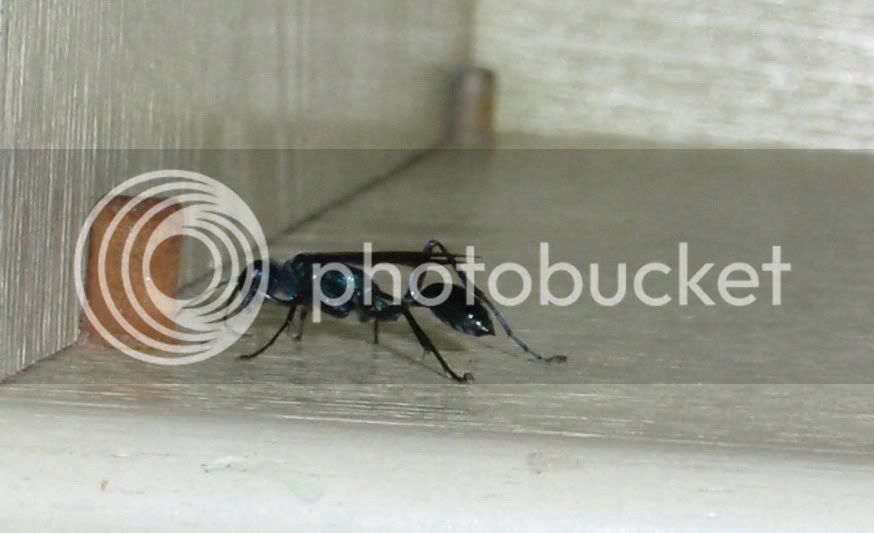You are using an out of date browser. It may not display this or other websites correctly.
You should upgrade or use an alternative browser.
You should upgrade or use an alternative browser.
Cockroach killer wasp
- Thread starter gadunka888
- Start date

Help Support Mantidforum:
This site may earn a commission from merchant affiliate
links, including eBay, Amazon, and others.
[email protected]
Well-known member
[SIZE=14pt]cool do they olny go after roaches, over here in the states we have some that will take any kind of insects not just roaches.[/SIZE]
ABbuggin
Well-known member
Cool. I enjoy seeing these pics/videos of exotic insects. 
gadunka888
Well-known member
thanks for the ID Christian.
From wikipedia:
From wikipedia:
wow i never knew that! My mother used to see lots of these wasps eating cockroaches when she was young.Most species sting the roach more than once and in a specific way. The first sting is directed at nerve ganglions in the cockroach's thorax, temporarily paralyzing the victim for 2–5 minutes - more than enough time for the wasp to deliver a second sting. The second sting is directed into a region of the cockroach's brain that controls the escape reflex among other things. When the cockroach has recovered from the first sting, it makes no attempt to flee. The wasp clips the antenna with its mandibles and drinks some of the haemolymph before walking backwards and dragging the roach by its clipped antenna to a burrow, where an egg will be laid upon it.

$16.99 ($16.99 / Count)
Josh's Frogs Freshly Started Flightless Drosophila Hydei Fruit Fly Culture
Josh's Frogs

$12.99 ($0.03 / Count)
Predator Foods Bulk Live Mealworms - 500 Count (Medium - 0.5")
Predator Foods

$13.99 ($0.44 / Ounce)
Fresh Fruit Fly Culture (Drosophila Hydei) - Praying Mantis Mantid Frog Lizard Food - 32oz Cup
Surmen Legacy

$3.19 ($42.53 / lb)
$6.09 ($81.20 / lb)
Fluker's Gourmet Canned Food for Reptiles, Fish, Birds and Small Animals, Black, Mealworms 1.23 Ounce (Pack of 1)
Amazon.com

$14.59 ($14.59 / Count)
Butterfly Breeding Net Folding Butterfly Habitat Cage White Butterfly Mesh Cage for Kid Garden Science Education Tool 40x40x60cm Butterfly Cage
Hubeichunliangnongyefazhanyouxiangongsi

$18.99 ($2.12 / Ounce)
Josh's Frogs Producing Wingless Drosophila Melanogaster Fruit Fly Culture
Josh's Frogs

$15.99
$19.99
RESTCLOUD Insect and Butterfly Habitat Cage Terrarium Pop-up 23.6 Inches Tall
Restcloud

$34.99
$39.99
RESTCLOUD 30" Large Monarch Butterfly Habitat Cage, Outdoor Insect Mesh Cage Terrarium 16.5" x 16.5" x 30"
Restcloud

$39.95 ($1.25 / Ounce)
Creation Cultivated 32oz Fruit Fly Culture - Live Feeder Insects for Praying Mantis, Jumping Spiders, Geckos, Lizards, Dart Frogs (Drosophila Hydei Flightless)
Creation Cultivated

$13.99 ($223.84 / lb)
Surmen Legacy Freshly Started Wingless Drosophila Melanogaster Fruit Fly Culture
Surmen Legacy

$13.99 ($13.99 / Ounce)
Surmen Legacy Freshly Started Flightless Drosophila Hydei Fruit Fly Culture
Surmen Legacy
Morpheus uk
Well-known member
Saw someone on flickr once who actually bred these, bet it would be very interesting.
ABbuggin
Well-known member
Oh, wow! Does sound like fun.Saw someone on flickr once who actually bred these, bet it would be very interesting.
Imagine if you could get it to lay an egg on a Blaptica dubia female.Sphecid wasps won't take "any kind of insects" but are host specific. Ampulex, that's the one in the pic, only takes Periplaneta roaches.






































